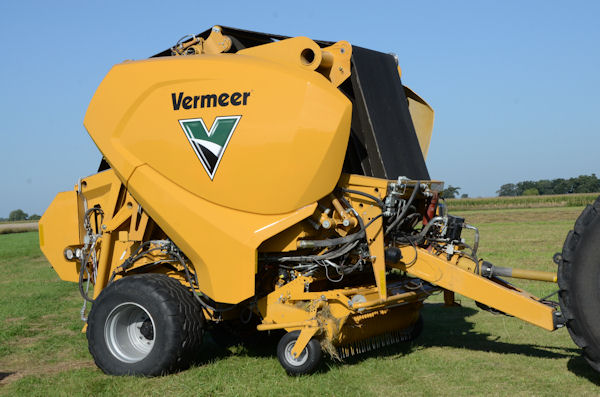April 29, 2015

It's not often in the farm equipment business do you get an early look at a machine and get to follow along as its developed. Last fall Vermeer had a big sales meeting, where media was invited, and it showed off its continuous round baler, shortened to CRB by the company.
Part of the reason for showing it off was that field development was underway and the company knew farmers and others would see the machine at work. In fact, the company even rolled out a website for the developing machine where people could register to be kept up to date on its development - crb.vermeer.mobi.
So where is the machine today? We talked with Phil Chrisman, product manager - beef, Vermeer, who has been involved with the baler's development from the start. "Since the sales meeting last September we focused in the fall on corn-stalk balking activities," he says. "Corn stalks [had been an] an issue for us and had not been super successful in previous attempts."
Corn stalk baling has potential not only for livestock feed, but also for the potential rise of cellulosic ethanol marketing opportunities too. Vermeer has been a solid performer with its Corn Stalk special baler, and it wants to offer the CRB tech to the market.
Chrisman explains that after the initial hiccup with corn stalk balking with the CRB, the company took a step back and rethought the approach. With a few changes, the company then baled between 2,000 and 3,000 bales with a new setup. Essentially Vermeer engineers took the pickup from the popular Corn Stalk special baler and adapted it to the CRB.
There's a difference between hay baling and corn stalk baling. "The CRB was fantastic for typical hay. We designed in the corn stalk special and it was a big leap forward," he says.
The final approach to the problem is still to be determined, but it appears Vermeer is aiming for a single model that can handle all key crop types. That could mean more of a hybrid design. Vermeer is developing the new baler in cooperation with Lely. "We want to build a single machine to do everything," Chrisman says. "Ideally, we don't want two different pickups as options on a product like this."
Winter testing
After fall corn stalk testing, the baler went to Florida for the winter where Chrisman says several thousand bales were run through the machine. That's where more work was done on the belt design. The baler showed at the sales meeting had a single endless belt, but there were some durability issues. "In Florida we worked with different belt configurations," Chrisman says.
In the CRB the belt is always under tension which is different than a conventional baler. "The baler is just back from Florida and we're looking it completely over to get it ready for the start of the hay season," Chrisman says. "Do we used laced or endless belts? We're looking at the pros and cons of all of it."
As part of the testing, Vermeer is learning how this technology can improve productivity. And the boost can vary? "It can be as high as 50%, but the caveat on that is bale size and crop volume," he says.
He shares a couple scenarios to put that productivity boost into perspective.
The baler can make up to a 6-foot bale, but in areas like the Northern Florida dairy area where ryegrass silage is being baled and you have a high-tonnage per acre you're looking at wetter bales and a higher bale count per acre. In a situation like that a normal baler is stopping a lot to drop the bales. It's in those high-yield, multiple bale situations where the CRB shines and offers up to a 50% productivity improvement.
At the opposite end of the spectrum would be Texas in August with bermudagrass and little rain where you're baling a thin field. In those conditions you might get two bales per acre, which pretty much "negated all the benefits of continuous baling," Chrisman says.
The future potential buyer will have to look at their operation to determine the payback of a CRB and with its complexity and size, it will carry a higher cost (not yet determined). In addition, you'll need a bigger tractor. For tests Vermeer has been running a Case IH Puma 195 with about 170 pto hp. They haven't been using the baler with silage knives in the throat, which can also add to horsepower needed.
"If you added knives you would need around 200 pto hp, and that's the size that Lely is targeting for their typical silage market," Chrisman says. It's another consideration for the Vermeer CRB.
Farmer reaction
It's a heavier baler. The CRB will require more horsepower to operate. And it will cost more than a conventional round baler. "Almost everyone who sees it will say 'when can I get one?'," Chrisman says. "Since the sales meeting we get several calls a week to know where its testing, and asking if they can get it on their operation. In the off-season I attended some dealer open houses and farmers always ask about that baler to find out our progress and where we're testing."
And interested farmers will get their chance to see it around the country this year (signing up at that website above won't hurt).
As for the official launch of the new machine? Chrisman is non-committal: "It's too early to say when the launch will be, it's out there farther than my crystal ball," he notes.
About the Author(s)
You May Also Like






